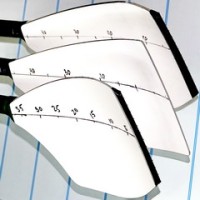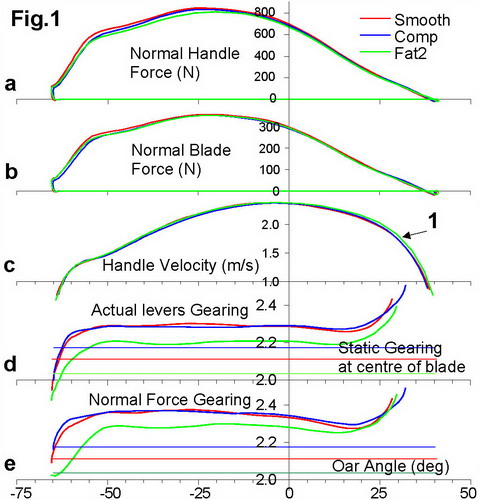Gearing and efficiency of blade types

We continue analysis of various blade types using prior data (RBN 2021/09) taken in M1x with Smooth (88/288cm, 34.8spm), Comp (88/288cm, 35.2spm) and Fat2 (88/282cm, 34.5spm) blades, and try to answer the following questions:
- How does the shorter outboard in Fat2 affect efficiency and performance?
- With the same rigging in Smooth and Comp, what was the difference in performance?
The normal handle force (Fig.1,a, Tab.1,2) was the highest in the first run with Smooth blades, then decreases by 2% in the second run with Comp, and by 5% in third run with Fat2. The handle velocity was the highest with Fat2, especially before the finish (Fig.1,1), so its average value over the drive (Tab.1,3) was 0.7% lower for Smooth and Comp, which is the first evidence of lighter gearing in Fat2.

Further evidence of lighter gearing was that the highest normal blade force in Fat2 (Fig.1b, Tab.1,4), where the average value over the drive was 3.7% higher than in Comp and 5.1% higher than in Smooth. The gearing ratio defined with actual outboard/inboard levers (Fig.1d) corresponds very well to the reversed ratio of the handle/blade normal forces (e): the first one was by 3.9% and the second one by 3.0% lower-lighter in Fat2 (Tab.1,5-6, average from -50o to 0o oar angle). The “burden factor” HDF (RBN 2020/04-5) was the heaviest in Smooth - 110 kg/m, slightly lower 109 kg/m in Comp, and the lowest 101 kg/m in Fat2, which means rowing feels lighter with these blades.
Analysing propulsive forces, Fat2 produced much higher X blade force during the first half of the drive (Fig.2a, Tab.1,7), so its propulsive (dynamic) gearing (b, ratio of the handle normal/X blade propulsive forces) was significantly lower - lighter. However, this was achieved by means of slower velocity of the blade CP (centre of pressure) relative to the boat (Fig.2c-1, Tab.1,8), which is a consequence of the shorter outboard in Fat2.

As a result, the blade propulsive power (Fig.2d, Tab.1,9) was the highest in the Comps, 2.7% lower in Smooth and 3.4% lower in Fat2.

Comparing propulsive forces produced by the blade (Tab.1,10, averages over the cycle) and their transfer to the rower-boat system (11), the highest efficiency was found in Comps (12) confirmed with a similar ratio of system/blade propulsive powers (13). This could evidence that longer Fat2 and Smooth blades consume more energy via rotation in the water during the drive.
Answering the above questions:
- Shorter outboard in Fat2 makes oar gearing lighter, blade forces higher, but at the cost of lower blade velocity, so overall propulsive power and efficiency were lower.
- At the same rigging, Comps have shown the highest efficiency of power transfer from the blade to the system, which could be explained by shorter length - less losses on blade rotation and lower axial forces.
- Acknowledgements: Thanks to Dick Dreissigacker and Alex Dunne of Concept2 Inc. for support of this study.
©2021 Dr. Valery Kleshnev www.biorow.com



